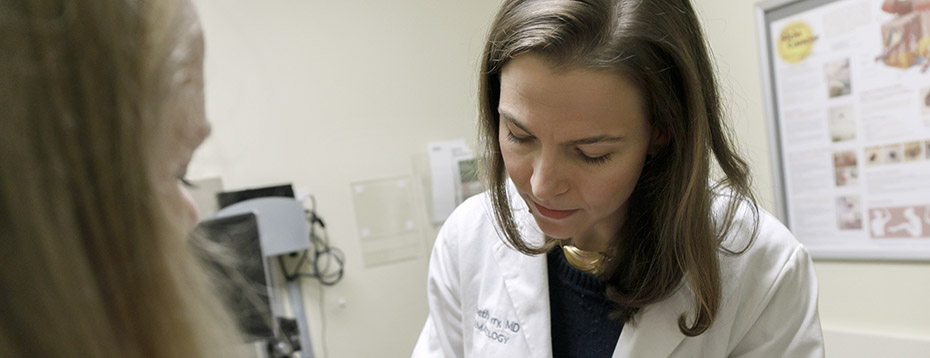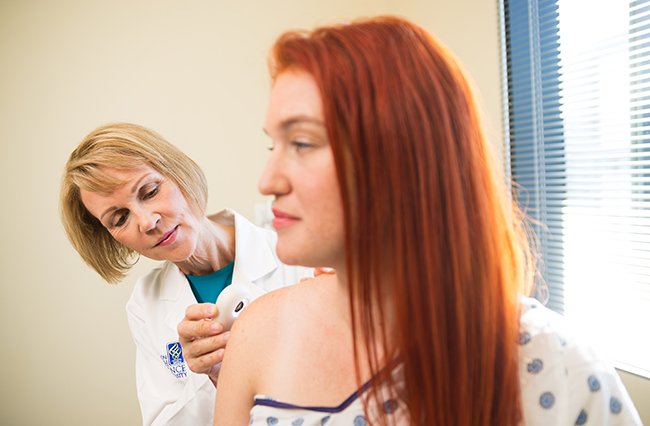Skin Cancers (Nonmelanoma)

Our skin cancer team has extensive experience and the most advanced technology to diagnose and treat nonmelanoma skin cancers. We offer you:
- Treatment recommendations tailored to your individual needs.
- Advanced diagnostic expertise and techniques.
- Dermatologists who are fellowship-trained in Mohs surgery. This is an especially effective treatment for many nonmelanoma skin cancers.
- Prevention and screening services for patients at high-risk of nonmelanoma skin cancer.
- A full range of support services for you and your family.
Understanding skin cancer
What is skin cancer?
Skin cancer is by far the most common type of cancer. Most are nonmelanoma skin cancers, usually basal cell carcinoma or squamous cell carcinoma.
Who gets nonmelanoma skin cancers?
More than 4 million cases of basal cell carcinoma and more than 1 million cases of squamous cell carcinoma are diagnosed in the U.S. each year. The National Cancer Institute estimates that 40-50% of people in the U.S. who live to 65 will develop one of these cancers at least once.
Skin cancer risk factors
Nonmelanoma skin cancers occur most frequently in people who:
- Have spent a lot of time in the sun.
- Have fair skin, lighter hair color and blue or green eyes.
Other risk factors:
- Race: White people are at much higher risk of getting skin cancer than other people.
- Family history: You are at higher risk if you have a close family member who’s had skin cancer.
- Age: You are at higher risk if you are older than 50, probably because of more lifetime sun exposure.
- Gender: Men are more likely to get basal or squamous cell carcinoma, probably because of more sun exposure.
What causes skin cancer?
Almost all skin cancers are caused by repeated exposure to ultraviolet rays — most often from sunlight but also from sources such as tanning beds. The ultraviolet rays damage the skin’s DNA, which can lead to cancer.
Types of nonmelanoma skin cancers
Basal and squamous cell carcinomas make up more than 95% of skin cancers. The others are rare.
- Basal cell carcinoma: This type starts in basal cells in the epidermis, the skin’s top layer. It’s the most common of all cancers and rarely spreads. When caught early, it is highly curable.
- Squamous cell carcinoma: This type grows in squamous cells in the epidermis. It’s more likely to spread than basal cell carcinoma but is also highly curable when caught early.
- Merkel cell carcinoma: This rare, aggressive cancer is far more likely to appear in people whose immune system is suppressed. This includes those with HIV or who have had an organ transplant and are taking immunosuppressant drugs. This cancer appears as lesions or nodules (bumps) on sun-exposed areas. They are most often red, blue, purple or skin-colored, and often about the size of a dime when detected.
- Kaposi sarcoma: This rare cancer is caused by an infection with human herpesvirus 8. It can appear as a tumor on the skin or inside the body, such as inside the mouth. It became more widely known in the 1980s as people with AIDS and weakened immune systems developed it.
- Cutaneous (or skin) lymphoma: Lymphoma is a disease of the lymphocytes, a type of white blood cell. These cells are produced by your bone marrow and travel through your blood and lymph system. In rare cases, they clump together to form tumors in your skin. Find out more about our treatment for cutaneous lymphoma.
Skin cancer symptoms
Basal cell carcinoma:
Basal cell cancers most often develop on areas with the most sun exposure, such as the face, head and neck. They often appear as:
- Raised reddish patches that might itch.
- Open sores that don’t heal, or heal and return.
- Small pink or red bumps, which might include brown, blue or black areas.
- Pink growths that are raised around the edge and lower in the center.
- Pale or yellow areas that are similar to a scar.
Squamous cell carcinoma:
These cancers also most often develop on sun-exposed areas. Less often, they occur in the genital area. They often look like basal cell cancers but can also look like warts.

Skin cancer screening
Exams and technology
We offer you the tools and expertise to identify skin cancers when they’re most treatable. Services include:
- Full-body exams. These are often done each year.
- Advanced full-body photography to track changes over time. Our high-resolution DermSpectra system uses nine cameras and a private booth.
- Mole Mapper, a free OHSU smartphone app that helps you track moles between visits.
Clinic for high-risk patients
We offer additional prevention and screening services for patients at high risk of nonmelanoma skin cancer. These include people who:
- Have had an organ transplant.
- Have had long-term suppression of their immune system.
- Have an inherited genetic trait that puts them at higher risk of skin cancer.
Skin cancer diagnosis
Your doctor will look at any mark on your skin that seems suspicious. The doctor will ask when it appeared, whether its size or shape has changed, and whether it has been itchy or bleeding. They may do further tests, such as:
- Biopsy: A small tissue sample is removed and sent to a lab to check for cancer cells. The biopsy may remove the entire tumor, which can cure basal and squamous cell skin cancers. Skin biopsies are done with a local anesthetic.
- Shave biopsy: Your doctor shaves off the top layers of skin with a surgical blade.
- Punch biopsy: Your doctor uses a tool to remove a deeper skin sample.
- Incisional and excisional biopsies: For deeper tumors, your doctor uses a surgical knife to cut out a wedge or sliver of skin. The doctor may remove the entire tumor (excisional) or part (incisional).
- Lymph node biopsy: It’s unusual for basal or squamous cell cancers to spread, but your doctor might do a lymph node biopsy if any nodes seem enlarged.
Skin cancer treatments
Your care team will talk with you about the best treatment plan for your specific case:
Cryotherapy (liquid nitrogen freezing)
Cryotherapy is most often used for precancerous lesions and for small squamous cell and basal cell carcinomas. The doctor uses a handheld container to apply liquid nitrogen to the lesion or tumor, which freezes and kills the cells.
Surgery
Basal and squamous cell cancers are often treated with minor surgery.
- Excision: After numbing the skin, the doctor cuts out the tumor and some surrounding skin with a surgical knife.
- Curettage and electrodesiccation: The doctor can remove cancers confined to the top layer of skin with a long, thin instrument with a sharp edge. The doctor then uses an electric needle to destroy any remaining cancer cells.
- Mohs surgery: This may be used if the cancer is at risk of coming back, if the extent of cancer is unknown or if the goal is to save as much healthy tissue as possible. The surgeon removes a thin layer of skin and tissue at and around the tumor and examines it under a microscope. The process is repeated until no cancer cells are seen.
Topical treatments
For very thin basal or squamous cell carcinomas, a cream or ointment is put on the skin. It might be a form of chemotherapy that shrinks or eliminates the tumor, or it might help activate the immune system to shrink or eliminate the cancer.
Chemotherapy
In the rare cases that a squamous cell carcinoma spreads, your care team may recommend chemotherapy. Medication given in a pill or by IV circulates in the blood to kill cancer cells nearly anywhere in the body.
Radiation therapy
Your care team might use radiation, in the form of high-energy X-rays, if your tumor is large or in an area where surgery would be difficult. It can often cure basal or squamous cell cancers that are caught early. It can also slow the growth of advanced cancers. Radiation therapy is sometimes used with other treatments — after surgery, for example.
Targeted therapy
Targeted therapy drugs lock on to receptors on cancer cells, minimizing damage to healthy cells. They are effective in treating advanced or recurring basal cell carcinomas.
Learn more
- See a video about skin cancer on our Understanding Melanoma page
- Skin Cancer Treatment, National Cancer Institute
- About Basal and Squamous Cell Skin Cancer, American Cancer Society
- Basal Cell Carcinoma, Skin Cancer Foundation
- Merkel Cell Carcinoma Treatment, National Cancer Institute
- Merkel Cell Skin Cancer, American Cancer Society
- Kaposi Sarcoma Treatment, National Cancer Institute
- Kaposi Sarcoma, American Cancer Society
- Lymphoma of the Skin, American Cancer Society
Location
Knight Cancer Institute, South Waterfront
Center for Health & Healing, Building 2, ninth floor
3485 S. Bond Ave. Portland, OR 97239
Free parking for patients and visitors
Refer a patient
- Refer your patient to OHSU.
- Call 503-494-4567 to seek provider-to-provider advice.
Cancer clinical trials
Clinical trials allow patients to try a new test or treatment.
Read more
Learn more about OHSU Knight Cancer Institute treatments: